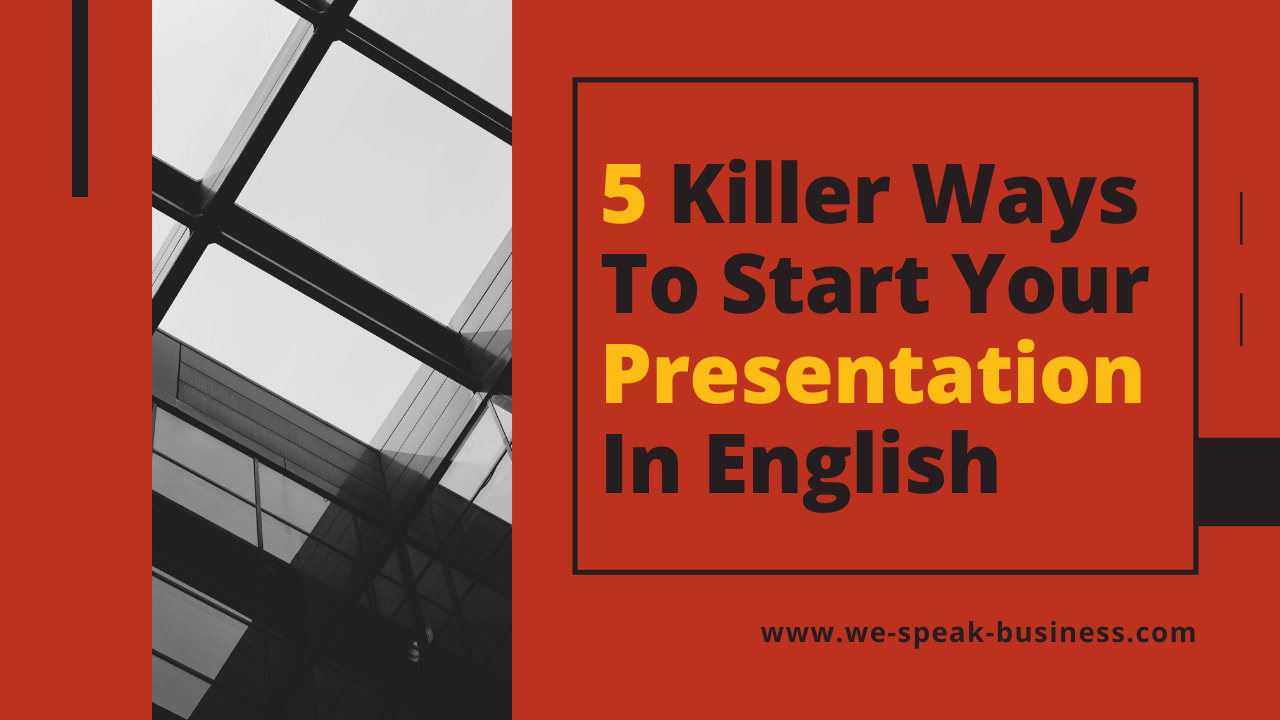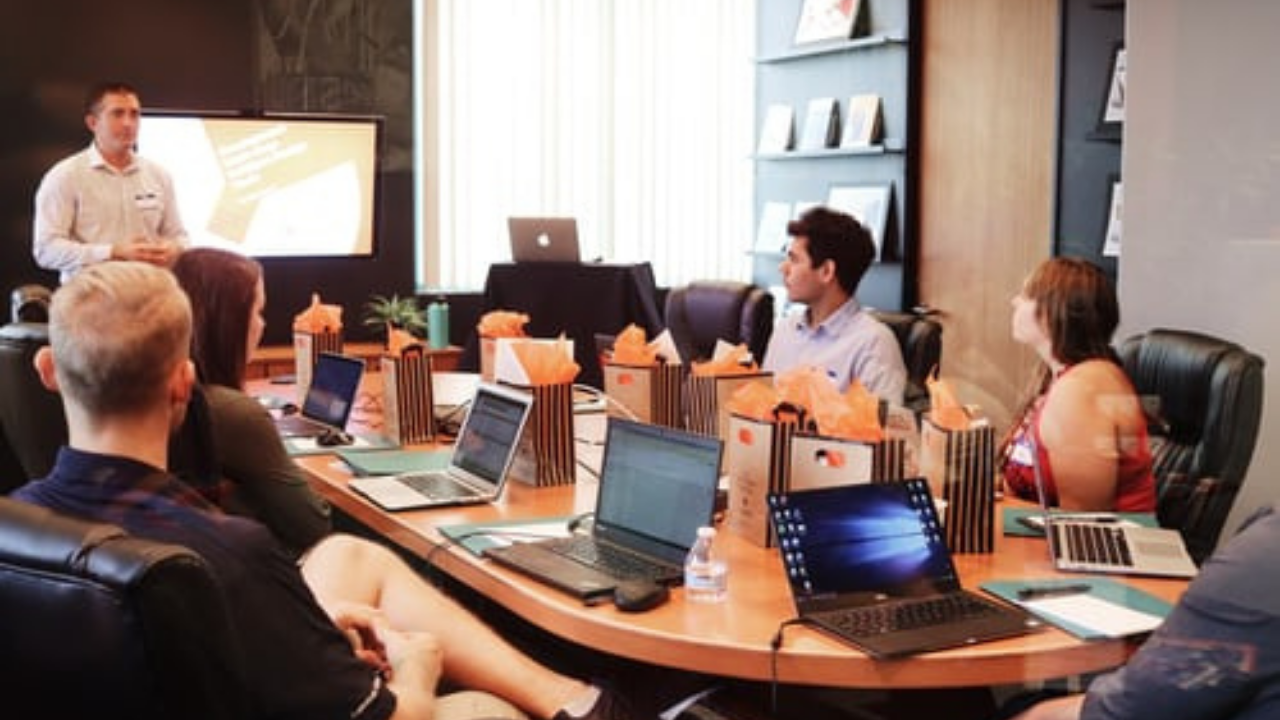5 Killer Ways To Start Your Presentation In English - Tips and Tricks
Jul 20, 2021
Ever wanted to be able to deliver a presentation that has the audience on the edge of their seats?
For someone to be sat ‘on the edge of their seats’ means they are fully engaged and locked into your talk, and this is exactly what we want to do when presenting a speech or delivering a presentation.
In this blog article, I’m going to share some of the best ways that professional public speakers and presenters use to open their talk or presentation in English.
How to Organize Your Introduction For a Presentation in English

Every good introduction for a presentation or talk should have a solid formula. Having some structure helps your audience know who you are, why you’re the expert, and what they can expect from your presentation.
As a General Rule of Thumb, Use This Outline For Your Next Presentation:
- Welcome the audience and introduce yourself
- Engage and capture the audience’s attention
- Identify and state your main goal or objective of the presentation
- Run through your agenda and the main topics/themes you will be discussing
- Tell the audience when you will taking questions
1. Introduce Yourself as a Person, Not a Presenter
I’ve noticed that out of the hundreds of presentations I have watched or sat in on, the ones that always grab my attention and make me want to listen are the ones who present themselves as a human as opposed to a presenter.
The reason? Humans like human-to-human interaction. We don’t want to see a robot standing at the podium speaking, we want to hear from a real person with real thoughts and emotions!
There are a few ways we can make our introductions sound a bit more ‘human’ and realistic.
Telling the audience something personal about you or how you got to the position you are in now is a great way to build rapport with the audience.
On the subject of rapport building, this is another fantastic way to establish a connection between you and the audience.
Some ways you can do this are by opening your presentation with:
“I was once like you…”
“My life up until this point has been no different to any of yours…”
“We’ve all felt like….before. That’s why my talk today is all about…”
2. Tell a Story
Presentation and public speaking experts still claim to this day that telling a story is hands down one of the most effective ways to open a presentation.
Humans are hardwired to enjoy and learn from stories. From bedtime stories and campfires to theatres and boardrooms. Every story can be in some way relatable to the audience and listener and this is what makes using a story so powerful - humans connect with stories.
The story can be about you personally and why you’re speaking about this topic in your presentation, or it could be about another person, like your colleague, friend, family member, or boss.
Another option is to tell a fable or historic event that resembles your story and the topic of your presentation. You’ll notice that a lot of presenters and speakers will use these kinds of stories as a metaphor for things they have actually gone through and faced in their lives, and something that the audience will also be able to relate to.
It’s important to point out that we don’t always need to literally tell the audience that we’ll be telling them a story, rather we should leave a 5-second pause at the very beginning and just go straight into it. The story shouldn’t be any longer than a few minutes, and it should get to the point quickly and effectively.
Here are some common ways we can start telling a story in English:
“I’d like to start my talk today by sharing an interesting story with you”
“Something strange happened to me the other day....”
“One of my most vivid memories was…”
“When I was [age], I used to…”
3. Ask a Question
Asking a question is another exciting way to open a talk or presentation. It not only gives the audience something to think about or consider, but it keeps them engaged throughout the entire presentation in the hope that the question will be answered at the end.
Movies do exactly the same thing. They might tease the audience at the beginning of the film with a burning question or problem, and you sit and watch the movie in anticipation in the hope that the answer will soon be revealed.
There are two types of good questions we can ask to start a presentation. The first one is “What of…” questions.
Ask a “What if…” Question
Drawing your audience into your speech right away works brilliantly. Asking a “what if” question invites the audience to follow your thought process.
“What if we were all robots? How different would our everyday lives and society be? What would happen if we were to speak our real minds on a daily basis? How would that affect our interactions and relationships with others?
Ask a Rhetorical Question
A rhetorical question is a question that we don’t expect an answer to, usually because the answer is either obvious to everyone. Rhetorical questions have been around for centuries and famous playwrights like William Shakespeare was a big fan of them. After asking our rhetorical question, we would then go on to explain the topic of the talk/presentation.
Some examples of rhetorical questions are:
“Would you like to work less and make more money? Would you rather be sitting in a hammock all day rather than a stiff office chair? The topic of my presentation today is all about ‘passive income’.
“How great would it be if politics united us as opposed to dividing us? Today I’d like to talk to you all about the dangers of identity politics.”
“Ever wished you were a millionaire and wondered how much easier your life would be? I’m going to share with you today why having a lot of money isn’t actually all it’s cracked up to be and why it didn’t make my life any less difficult.”
4. Open With a Hook

A ‘hook’ is something that captures your attention and engages you straight from the off. A ‘hook’ can be a headline, fact, or shocking statistic. These kinds of openings are very common in scientific presentations or presentations where the speaker wants to emphasize the importance of something.
A good tactic is to leave a slightly long, dramatic pause after you have read your headline, fact, or statistic. This adds drama to our talk and also gives the audience time to digest the information and think about it a little more.
Think about information or data that is relevant to your talk and how it can be used to introduce the topic of your presentation, and consider different ways to present it as your opening.
Here are some examples of how to open with a hook:
“Did you know that the strongest muscle in your body is your tongue?”
“Has anyone ever noticed that the Mona Lisa has no eyebrows?”
“Most people believe that the colder something is, the quicker it will freeze. However, hot water will actually turn into ice quicker than cold water.”
5. Use a Powerful Quote
Our final way to open a presentation in English is to tell the audience a powerful quote that is relevant to your talk. Quotes can brilliantly summarize a complex, big idea making it more enticing for your audience.
“Employ the wise words of a well-known person because the name allows you to tap into his or her credibility, likeability, and notoriety,"
Imagine you’re giving a talk on motivation. You could open with: “Elon Musk once said, ‘If something is important enough, you’ll do it even if the odds are not in your favour.’
The quote needs to have meaning and relevance to the topic, so if you’re doing a talk on the advantages of remote work, don’t use a quote that has anything to do with the negatives of remote work.
What is We Speak Business Program
We Speak Business is an English course with live speaking lessons for English learners who want speaking practice with native speakers, professional teachers, and students from around the world.
You have live speaking lessons where you can join and start speaking business English every day. There's a lesson every day and also, you can review all record lessons. There is a lot of conversation practice for each level of English (A2, B1-B2, C1). There is a calendar of scheduled lessons so you can see when lessons are and at what time you can join and start speaking.
In We Speak Business program, you have 24/7 support and also you have student chat where you can speak with other students from all around the world. Before you join our program and start speaking business English, we strongly recommend you sign up for our free seminar with Andrew Smith, where you can learn:
- What goals you need to have to get better results
- How to master business English quickly
- What are the strategies that will help you advance to a higher level
- How you can speak business English more fluently and confidently
- Free resources to help you learn business English
- Exclusive resource to improve your speech
In Short
Now that you know the top five ways to open a presentation or speech in English, why not have a go at writing some yourself? You can make up an imaginary presentation or use a previous talk you’ve already given or are planning to give.
Try using a few different techniques that we’ve outlined today and see what works best for you, and work on the ones that you struggle with. Using a variety of openings for different presentations is best because you don’t want to be associated as a person who always uses the exact same style of opening.
If you’re looking for new, clearer and more professional ways to open a presentation or talk in English, then I’d like to invite you to our exclusive FREE seminar, where I have condensed ten years of business English experience into an interactive 2-hour seminar.
In our free seminar, I’m going to teaching you how to set realistic language goals, how to learn and grow your business vocabulary quickly and effortlessly, how to speak and pronounce words in English so your global colleagues and clients can understand you, and at the very end, I’m going to be offering you a chance to go a step further...
To join the free seminar simply click the button below to reserve your spot now. You definitely won’t want to miss it!
To your success!
If you are looking to improve your speaking skills at work, then we have an exclusive free seminar where I teach you how to speak better business in 30 days. Sign up by clicking the button below!



